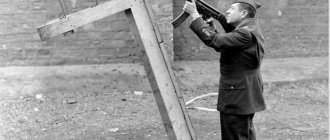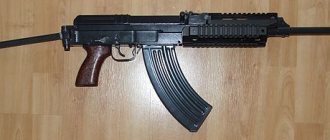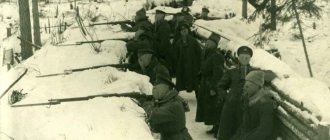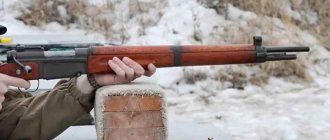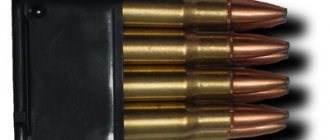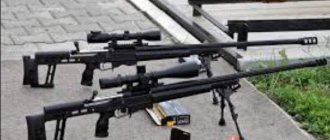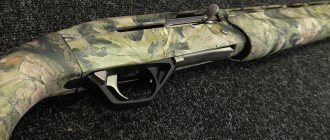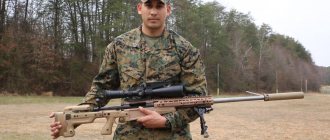The G11 Heckler rifle serves as an individual small arms weapon for a Bundeswehr soldier and is designed to defeat enemy personnel. The G11 Heckler rifle is the development of West German designers, which replaced the G3 rifle.
G11 Heckler rifle
In the mid-60s of the 20th century, the concept of armament of motorized infantry units of NATO armies, including units of the Bundeswehr, began to change. According to NATO analysts, the main strike “self-defense forces,” as the arms race businessmen liked to call themselves, are armed with an assault rifle that is not light enough to meet modern requirements.
Story
The history of Heckler und Koch begins in 1949. After the Mauser arms factory was destroyed by French troops in 1945, leading engineers Edmund Heckler
) (February 2, 1906 – 1960), Theodor Koch
(
May 13, 1905 – 1976) and Alex Seidel
(
1909 – 1989) salvaged what they could from the wreckage, and that was actually the beginning founding of a new arms company.
In December 1949, Heckler und Koch GmbH was officially registered, but at first the main activity was not the production of weapons, but helping to rebuild the country from the consequences of World War II. The company produced mechanical engineering equipment, sewing machines, measuring equipment and much more. The situation changed in 1956, when new weapons were needed to arm the Bundeswehr. Using the developments of the Mauser company, H&K engineers created a rifle that went into service already in 1959. The G3 automation system was borrowed from one of the Mauser developments (semi-free bolt with roller delay) and became, in its own way, the hallmark of many weapons produced under the H&K brand. The rifle turned out to be very successful, both in terms of reliability and cost, since H&K engineers widely used stamping instead of expensive machining.
In the mid-60s, the company, based on the G3, produced the MP5 submachine gun, which very soon became one of the most popular submachine guns in the world, entering service with many intelligence services in various countries. The MP5 series model range has expanded over the course of 30 years and today the MP5 has about a dozen modifications, including the SD (with integrated silencer) and MP5K (short MP5) models.
In addition to the MP5, the PSG-1 and MSG-90 sniper rifles were also released based on the G3.
In the 60s, H&K began developing a rather unique assault rifle, the G11, which was supposed to replace the G3. The uniqueness lay, firstly, in the ammunition (caseless cartridges of 4.7 mm caliber were used), and secondly, in the automation system (when firing with a cut-off of 3 shots, the recoil began to affect the shooter after all three bullets left the barrel channel). By 1990, development was completed and the G11 began to enter service, but the rearmament program was soon closed due to lack of finances due to the fall of the Berlin Wall and NATO requirements for the unification of ammunition.
The curtailment of the G11 program greatly undermined the financial position of the company, as a result of which the company, which was on the verge of bankruptcy, was acquired by the British concern Royal Ordnance. Heckler & Koch stayed afloat thanks to the fact that it fulfilled an order from the British Army to modernize the L85A1 rifles from many existing problems.
In 2002, British Aerospace/Royal Ordnance sold Heckler & Koch to private investors Heckler and Koch Beteiligungs GmbH.
In July 2003, production was divided into defense-arms and sports-hunting. To conduct business in the new, civilian market segment, Heckler & Koch Jagd und Sportwaffen GmbH (HKJS) was founded.
Pistols "Heckler & Koch" (Germany)
Founded in 1949 by Edmund Heckler and Theodor Koch, the company did not immediately begin producing weapons. At first, the company, called Heckler & Koch GmbH Oberndorf/Nekkar, produced tools and equipment, taking over positions lost in this market.
Later she took up handguns, achieving decent success in this activity. The first pistol produced by this company in 1956 was the HK 4. The reason for the appearance of this weapon was most likely the commercial success of the Mauser HSc pistol, produced in large quantities in Oberndorf during the Second World War. Actually, the HK 4 model, and this is noticeable even in its external design, is an improved HSc pistol.
Pistol "Heckler & Koch" HK 4
The designer of the new weapon was Alex Seidel, the creator of the HSc pistol. The HK 4 pistol, like its famous prototype, turned out to be simple and reliable. Experts who have used this pistol note its comfortable fit in the hand, as well as its low sensitivity to dirt, rain and snow. The pistol body is made of a special alloy of light metals, followed by surface hardening, which ensures lightness and increased wear resistance.
The main feature of this pistol was the ease of conversion for cartridges of various calibers, which does not require tools. Initially, the HK 4 model was chambered for the 9×17 mm Browning Short cartridge. Almost immediately, modifications of the pistol appeared for cartridges of 7.65 mm, 6.35 mm, and also .22 calibers. All variants of weapons were easily converted from one to another by replacing the barrel with a return spring, and in some cases, moving the firing pin into a specially provided hole. All modifications of the HK 4 pistol were sold, as a rule, separately, but the buyer of the base model chambered for the 9x17 mm Browning cartridge could purchase spare parts for any cartridge convenient for them.
In addition to the model for domestic use, an export version of the HK 4 pistol was produced in Germany. In the USA it was sold under the Harrington & Richardson brand. In the American market, modifications for .22 and 9 mm caliber cartridges were especially popular, sold in sets along with spare parts for conversion to another caliber.
In the mid-1980s. curtailed the production of pistols of the HK 4 type. The reason for this, obviously, was both the insufficient power of the 9x17 mm Browning cartridge and the appearance of self-loading pistols from other competing companies (for example, the updated Mauser-Werke for almost ten years - from 1968 to 1977. — produced the original model of its HSc). By that time, the 9×19 “Parabellum” cartridge, which combines sufficient lethal power with low recoil when fired, became the standard for ammunition designers around the world for pistols and submachine guns. Most of the leading European pistol manufacturers have re-equipped their production facilities to produce weapons chambered for this cartridge, and have also followed this path.
Pistol "Heckler & Koch" P 9
After the success of its HK 4 pistol, it was not difficult to gain a foothold in the firearms market. At the end of the 1960s. The HK P 9 pistol was developed and put into mass production. The fate of this weapon was rather strange. Being quite reliable and effective, the pistol earned a good reputation among the police and border forces of Germany, although it was never officially adopted into service in Germany. A special feature of this weapon was a unique slow-opening bolt system, identical to the system of the German G 3 rifle produced by Heckler & Koch. In turn, this rifle was not a completely original product; in particular, this system was used in the best German machine guns of the Second World War, MG 42. The bolt, consisting of two parts, moved gently along the rollers when firing in such a way that there was no recoil when firing was significantly lower than in many samples of pistols chambered for the 9×19 “Parabellum” cartridge. This is what made it possible to release a modification of the pistol chambered for the powerful .45 ACP cartridge, and the P 9 is still one of the smallest 45-caliber pistols. Another distinctive feature of the HK P 9 pistol is its patented invention concerning the shape of the barrel. Having a polygonal cross-section, the pistol barrel is surprisingly short. When a bullet passes through a barrel of this shape, friction is much less, and therefore the bullet speed, shot accuracy and target range are higher. With a conventional (round with rifling) barrel shape, to achieve the same characteristics, the length of the weapon would have to be increased by almost 1.5 times.
Of the modifications of the P 9 pistol, the P 9 S model chambered for the .45 ACP cartridge, production of which began in 1977, deserves attention. This pistol was obviously intended for export to the USA, where the position of the traditional 45-caliber cartridge is still strong. In addition, the P 9 pistol was modified to accept the less powerful 7.65×22 “Parabellum” cartridge. There was also a modification of the P 9 “Sport”, equipped with an elongated barrel and intended, as the name suggests, for sports use.
Read: Stechkin APS automatic pistol (USSR-Russia)
Despite many advantages over its main competitors, the HK P 9 pistol was produced for only about 20 years. Main production of this pistol ceased in the late 1990s. The likely reason was the complexity of the design and the high cost of manufacturing the pistol, which, in general, determined its reliability and small dimensions. The cost of manufacturing 75 parts, many of which were unique, turned out to be too high for the modern market (both military and civilian) oversaturated with various models.
By the early 1970s. , which already had several very successful developments, achieved considerable success in the firearms market and found itself among the leading arms manufacturing enterprises. Now it was possible to engage in creativity - the development of non-standard, and therefore quite complex weapons. The engineers of this company took the next step: creating an automatic pistol capable of firing bursts. This type of personal weapon is quite peculiar, and the topic itself is rather thankless. Suffice it to say that among several dozen similar samples, only a few turned out to be successful and a few reached mass production.
The specialists, as always, approached the task creatively. Leaving unchanged their main difference - the miniature size of the weapon (here the word “most” is appropriate again - this time the creators of the weapon turned out to be the smallest automatic pistol in the world), the developers did not deviate one iota from the criteria of reliability and efficiency. The HK VP 70 pistol model, whose production began in 1973, combines an unprecedented rate of fire with the consistent quality of the Heckler & Koch brand.
Once again, the subsequent history of this pistol turned out to be quite strange. Having embodied all the advanced engineering solutions of that time, this model never achieved sustainable success in the weapons market comparable to the success of other models of the German company, at least the HK 4 or P 9 pistols.
Pistol "Heckler & Koch" VP 70
The HK VP 70 pistol is designed for single and burst shooting with 9×19 “Parabellum” cartridges. This was not the first time that another creation by the Heckler & Koch developers had a design feature that at that time became a new word in the development of individual small arms. One such feature in the VP 70 model was the absence of a fuse as a separate unit. From the point of view of the shooter’s sensations, the firing process was divided into 2 phases: “heavy”, during which the trigger went through the initial safety phase of its movement, and “light”, which completed the movement of the trigger, after which the shot occurred. At the same time, the shooter clearly felt both phases by the force of resistance of the trigger, which ensured the automatic removal of the pistol from the safety and the speed of introducing the weapon into battle.
The HK VP 70 pistol was produced in two main modifications: “Military” (VP 70 M) and “Civil” (VP 70 C). The design differences between these types were so great that some experts called the VP 70 M model an automatic machine. This model was equipped with a holster, which was also a butt and made it easier to fire in bursts. Firing in bursts was only possible with a holster attached, so the civilian model VP 70 C was not considered an automatic pistol.
A fire mode translator was mounted on the butt, which was connected to the pistol’s firing mechanism. A special feature of this type of pistol was its high theoretical rate of fire (about 2200 rounds/min). Considering that the fire was carried out only in the 3-round burst mode, this rate of fire made it possible to accurately fire three bullets before the barrel began to throw up due to the recoil effect. Of course, this contributed to the exceptional destructive power of fire while maintaining the accuracy of pointing the weapon at the target.
The pistol had a minimum of moving parts in its design and was equipped with a 2-row magazine, which significantly reduced the size of the weapon.
In general, once again we have a “signature dish” that combines the best qualities of traditional products with an innovative approach to creating an automatic pistol. These weapons were equipped with airborne units, armored vehicle crews, as well as German security officers. The pistol was also supplied to some countries in Europe, Asia and Africa. Moreover, the fact that production of the VP 70 was discontinued in the mid-1980s is not entirely clear. due to decreased sales volume.
Thus, this weapon became another example of an automatic pistol, reliable and effective, but too complex and expensive for mass production and too specific for mass use. One way or another, she focused her efforts on developing other types of firearms.
Pistol "Heckler & Koch" P 7
In 1976, a new type of pistol was introduced, initially designated PSP (Polizei selbstlade Pistole - police self-loading pistol). This weapon was developed specifically to meet the strict requirements of the German police. Since 1979, after a series of successful tests, the weapon has been mass-produced under the designation HK P 7.
Read: 13.3 mm MG.18 (TuF) machine guns - the first large-caliber
The self-loading pistol of the P 7 brand is considered a weapon that is maximally adapted to the needs of the police and special units. And although a pistol of this type was subsequently adopted by the German army, its reputation as a “special” pistol was established for many years.
Gunsmiths consider the design of the HK P 7 pistol to be almost the most original in the history of the creation of police pistols. The engineers tried to satisfy almost all the requirements for police weapons. Thanks to engineering solutions that were largely innovative for its time, the weapon turned out to be as compact as possible with increased efficiency and reliability.
First of all, the creators of this weapon abandoned the blowback design used in the HK VP 70 model. The results of combat use of this pistol indicated that the semi-blowback design was most suitable for firing the 9×19 “Parabellum” cartridge.
The second innovation in the design of the P 7 pistol was a unique system for slowing the opening of the bolt, based on the energy of powder gases. This method, typical for rifles and machine guns, is extremely rarely used in pistols. The use of such a complex design solution is explained by the need to keep the dimensions and weight of the weapon within strict limits, despite the fact that the ammunition is a powerful cartridge with a high muzzle velocity and recoil energy. The work of police forces and special services is characterized by the situation of immediate use of firearms, when milliseconds of delay can not only decide the outcome of the operation, but also take the life of a representative of the law.
The HK P 7 pistol most fully meets the criteria for special operations, ensuring immediate use of the weapon without removing the safety.
The HK P7 pistol was produced in several modifications. Type P 7 M 8 was equipped with a magazine with a capacity of 8 rounds of 9x19 mm caliber, P 7 M 13 - respectively 13.
There was also a simplified version of the R 7 K 3, which did not have a shutter opening delay system based on the use of powder gases. This pistol was intended to use less powerful 7.65 mm and 9x17 mm cartridges. In addition, German gunsmiths could not ignore the American firearms market. A very interesting, but equally complex modification of the P 7 M 45 used the powerful .45 ACP cartridge as ammunition. This model had to be equipped with a hydraulic oil system to slow down the opening of the bolt, which made it possible to maintain the previous compact dimensions of the pistol. However, this decision complicated the design so much that it was decided to abandon the release of this modification due to the high cost of the weapon.
The P 7 pistol has the minimum dimensions and weight, as far as possible for the Parabellum cartridge. Safety when carrying a weapon in a cocked state and readiness to fire without using a special lever to remove the safety are assessed at a high level. Thanks to the smooth surface and the absence of protruding parts, the pistol is conveniently, quickly and safely removed from a holster, bag or pocket. Using the weapon is equally convenient for both right-handers and left-handers.
Currently, the P 7 pistol has established itself as one of the best examples of individual small weapons and has been adopted by the army, police and border troops of Germany. In addition, this type of pistol, despite the traditionally high cost for Heckler & Koch weapons, was appreciated by the civilian population of many countries around the world, which ensured considerable commercial success in the civilian weapons market.
Pistol "Heckler & Koch" USP
In 1993, she presented one of her latest developments - the HK USP pistol (Universale selbstlade Pistole - a universal self-loading pistol), which was immediately created for the two most common cartridges on the international market - 9x19 "Parabellum" and .40 "Smith & Wesson" .
USP models for these ammunition were designated NK USP 9 and NK USP .40, respectively, and were positioned primarily as military and police weapons.
One of the notable features of the USP family of pistols is the large selection of trigger mechanism options (up to 10), which allows you to fully satisfy the needs of a wide variety of consumer groups, including civilians, officers or soldiers of the army and special forces, as well as police officers and anti-terrorism units .
Another feature of the USP pistol was the ability to fire high-pressure .40 S&W cartridges to hit targets protected by body armor. During testing, the new Heckler & Koch weapon, despite its small size, demonstrated impressive accuracy characteristics: dispersion when firing at a distance of 25 m was only 63 mm.
Read: 21st Panzer Division of the Wehrmacht
In 1994, it introduced a compact modification of the pistol, designated USP “Compact” (the designation usually also included the caliber, for example USP 9 “Compact”). In 1995, a modification of the USP .45 chambered for the .45 ACP cartridge was developed, aimed mainly at the US market. Soon a modification of the USP .45 “Compact” appeared, which turned out to be very popular. The USP .45 model is also suitable for firing special high pressure .45 ACP cartridges.
In addition to these “combat” modifications, Heckler & Koch has released a number of USP “Match” sporting models, featuring a polygonally rifled barrel, a special trigger adjusted to the requirements of target shooting, an open sight adjustable in two planes, and the presence of a muzzle brake. A USP “Expert” model was also released (for all of the above cartridges), designed specifically for European competitions according to IPSC rules and featuring a barrel extended to 152 mm.
The HK USP pistol has been officially adopted into service in Germany. The USP 9 modification, equipped with a double-action trigger with a single flag combining a safety and a decocking lever, was adopted by the Bundeswehr under the designation P 8. The USP 9 “Compact” modification, designated P 10, is the standard pistol of the German Federal Police. Particular attention should be paid to the “American” modification of the HK USP pistol.
In 1992–1993 In the United States, personal weapons were tested under the program to create an assault pistol for special forces of the US Army (US SOCOM). One of the “experimental” pistols was the West German USP .45.
It should be noted that the tests were carried out according to very stringent (and sometimes even exaggerated) criteria. Experiments in mud, water, sand and salt fog, as well as dropping from various heights onto hard surfaces with various weapon parts downwards, have become almost standard. In addition, for example, it was reported that one of the stages of the tests was the deliberate jamming of a bullet in the barrel followed by a second shot. As a result of such “bullying,” both bullets flew out of the barrel, while the latter inflated slightly with the possibility of subsequent firing.
Along with high accuracy rates, the German pistol demonstrated excellent results in terms of survivability. The bolt and frame withstood 60,000 rounds, and the barrel - 30,000 rounds with high-power .45 ACP cartridges without a single failure. Based on test results, the HK USP .45 was recognized as the pistol that best meets SOCOM requirements.
In January 1994, the Special Operations Forces Command entered into a contract with the American branch of West Germany to develop a second model of the USP .45 pistol, equipped with a silencer. The development of the latter was carried out by American engineers under a subcontract.
Soon, the USP .45 pistol with a silent-flameless shooting device by Dog Olson (designed by Knight's Armaments), a double-action trigger, a double-sided safety lever and a separate safety release lever was adopted by SOCOM forces under the designation "Mk 23 Mod 0 US SOCOM Pistol" " Currently, Mk 23 Mod 0 pistols are in service with almost all US special forces units, including the Green Berets, Delta Force, Navy SEALs, Rangers, and reconnaissance battalions of the Marine Corps.
The first batch of new 1950 Mk 23 Mod 0 pistols was purchased by the US Navy (which was also the customer for the development) already in 1996. In total, until 1999, under a contract totaling $12.1 million, the US Armed Forces received 7,500 pistols, 52,500 magazines and 1,950 Knight's Armaments suppressors.
Heckler & Koch P2000 pistol
The latest development is the HK P 2000 pistol, introduced in 2000 and which is a further development of the HK USP 9 “Compact” with a special design under the brand name CDA (Combat Defense Action). This type of trigger has a composite trigger with a special cocking mechanism, which provides the same and low trigger force with increased reliability. The new pistol, produced since 2001, is a compact weapon suitable for concealed carry, and is intended primarily for arming the police.
In addition to the basic model, variants of the P 2000 are produced with a simplified trigger that does not have a safety release lever. Such modifications are designated P 2000 V 1, V 2 and V 4 and differ only in the trigger force - 2, 2.8 and 3.3 kgf, respectively. The P 2000 V 3 version is not equipped with a CDA type trigger. Instead, a traditional double-action trigger with a safety release lever is installed.
You might be interested:
- Design of the Heckler & Koch HK4 pistol
- Design of the Heckler & Koch P7 pistol
- Design of the Heckler & Koch VP 70 pistol
- Heckler & Koch USP pistol design
- Design of the Heckler & Koch P 2000 pistol
- Design of the Heckler & Koch P9 pistol
Subscribe to
our channel in Yandex.Zen
Branches and divisions
USA
Heckler & Koch, Inc.
(addresses and exact coordinates: 38°53′03″ N 77°06′01″ W 933 North Kenmore Street, Arlington, VA 22201 - head office; 39°03′48″ N 77 °26′57″ W. 19980 Highland Vista Drive, Ashburn, VA 20147 - production) - since one of the mandatory conditions of competitions for the purchase of various small arms for the US armed forces and government agencies is their manufacture and delivery by a national manufacturer (strictly speaking, a resident company paying taxes on the sale of products to the federal budget and the regional budget of the state at the place of registration and location of production facilities), an American branch was specially created in the United States to participate in weapons development programs for the listed structures as a subsidiary company incorporated under state laws Virginia, location of the headquarters (Arlington) and weapons factory (Ashburn). Since the US Armed Forces are the second largest in the world in terms of the number of personnel on active duty and the third largest in the number of police officers, the American small arms market is a higher priority for the company in terms of potential sales profits, forcing it to concentrate the largest amount of scientific research on this area -research and development efforts to compete with other American and foreign manufacturers on the one hand, and on the other to meet the requirements of the tactical and technical tasks of the US Armed Forces.
Excerpt characterizing Heckler & Koch P11
Pierre worked with the chief manager every day.
But he felt that his studies were not making any progress. He felt that his activities took place independently of the case, that they did not touch the case and did not force him to move. On the one hand, the chief manager presented matters in the worst possible light, showing Pierre the need to pay debts and undertake new work with the help of serfs, to which Pierre did not agree; on the other hand, Pierre demanded that the matter of liberation be started, to which the manager argued that it was necessary to first pay the debt of the Guardian Council, and therefore the impossibility of quick execution. The manager did not say that this was completely impossible; To achieve this goal, he proposed the sale of forests in the Kostroma province, the sale of grassroots lands and Crimean estates. But all these operations in the manager’s speeches were associated with such complexity of processes, lifting prohibitions, demands, permits, etc., that Pierre was at a loss and only told him: “Yes, yes, do that.” Pierre did not have that practical tenacity that would give him the opportunity to directly get down to business, and therefore he did not like him and only tried to pretend to the manager that he was busy with business. The manager tried to pretend to the count that he considered these activities very useful for the owner and shy for himself. Source - ""
Categories:
- Weapons in alphabetical order
- Appeared in 1970
- Pistols of Germany
- Underwater weapons
- Heckler & Koch
- Multi-barreled weapon
Hidden categories:
- Articles with links to missing files
- Wikipedia: Articles with value overrides from Wikidata
- Pistol stubs
Manufactured products[1][2]
USP Compact, .40S&W
MP5
G36 with EOTech EO-552 sight, no magazine
HK21 belt fed
AG36 on a G36KV assault rifle in the hands of a Latvian soldier FABARM FP6
Pistols
- USP
- MK23 (English)Russian
- P30
- P2000
- HK4
- VP9
- VP70
- HK45
- HK VP/HK SFP
Prototypes
:
- UCP (English)Russian
Submachine guns
- UMP
- MP5 MP5 PIP[3] - MP5 design improvement option
Prototypes
:
- MP2000 (English)Russian
Rifles
Combat
:
- HK32 - version of G3 chambered for the Soviet 7.62x39 mm cartridge; was not adopted by any country
Sports
:
- HK SL6
- HK SL7
- HK SL8
Carbines
- SLB2000+
- SLB2000 Target
Machine guns
- HK21
- MG4
- HK121
- HK221[5]
Sniper rifles
- PSG-1
- MSG-90
- MSG-90A1
- SR9
Grenade launchers
- AG36
- HK69
- HK79
- AG-C/EGLM (English)Russian
- GMG
- M320
- XM25
Other
- FABARM FP6 (English)Russian - pump-action shotgun
- HK512 (English)Russian - semi-automatic shotgun
- CAWS - prototype automatic shotgun
- P11 - underwater pistol
- EFL[6] - device for launching a signal light
- P2A1 (English)Russian - single-shot signal pistol
